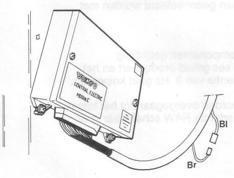F.A.Q. - Activating the CEM self-diagnose function
Something not everyone knows is that it is possible to let the CEM (Central Electric Module) perform a selfdiagnose. Not every CEM is capable of performing the CEM-selfdiagnose,
 |
CEM-versions with code 5 DK 004 696-01 in the Volvo 480
from chassisnumber 510200 are equiped with a self-diagnose system
giving you the option to test all incoming- and outgoing signals and
the CEM itself. (i.e. CEM Mark 1, Mark 2, Mark 3. Mark 0 has NO selftest function) The selfdiagnostic option of the CEM consists of the following three sequential tests: A) The internal test B) Automated testing of outgoing signals C) Test of incoming signals |
 |
Activating the CEM-selftest First remove the upper cover of the footwell on the left side of the car. Then remove the bonnet release lever and the cover behind it. Connect the blue wire near the CEM with the brown wire (earth). Engage either left or right turn signal. Make sure all electrical components are turned off and that all doors, bonnet, etc. are properly closed. Put the ignition key in position II. The testing procedure now begins. |
A) The internal test
After activating the selftest function the microprocessor in the CEM will be tested for about 1 second. When an error is detected in the microprocessor a buzzer in the CEM will beep for about 5 seconds.
When no error is detected the procedure will continue with:
B) Automated testing of all outgoing signals
In this part of the test the microprocessor of the CEM will sent, in the following order, all outgoing signals one by one:
| Testingorder | Signal to | Signalling for (sec.) |
| 01 | Seatbelt warning | 4 |
| 02 | Immobilizer | 4 |
| 03 | Interiour lights | 4 |
| 04 | Front wipers | 4 |
| 05 | Headlight washers | 0.5 |
| 06 | Long range lights | 4 |
| 07 | Horn | 0.5 |
| 08 | Direction indicators | 4 |
| 09 | Rear wiper | 4 |
| 10 | Rear demister | 4 |
| 11 | Airco | 4 |
By following the test step by step you can in which controlled function an error could be found. This because the test will be terminated at that point and the buzzer will produce a 5 second beep.
REMARK :
The CEM only tests the outgoing signal.
When, for instance, during testing the rear-demister doesn't produce an error signal this doesn't mean that the rear demister is working properly. The wiring between CEM and rear window could be broken.
Most components can, however, be tested visually or audibly. The functioning of the rear-demister can be tested by using a small lamp.
When all the above functions have been tested all components are switched on simultaneously for 2 seconds. Afterwards the buzzer will produce a 0.1 second beep and the seatbelt warninglight will start flashing at a 3 Hz frequency.
Immediately after the automated testing the procedure will continue with testing all incoming signals to the CEM, after you put the turn indicator in neutral.
C) Test of incoming signals
If one of the below components is activated, the buzzer in the CEM will produce a 0.1 second beep. This will indicate that the CEM receives a signal from the activated component. This way you know that the circuit is in prefect order.
If the buzzer doesn't beep either the tested circuit or the CEM is malfunctioning. Always check the wiring first.
Incoming signals to the CEM that can be tested are :
- Set alarm, doorlock (lock either passenger- / driverside door).
- Reset alarm, doorlock (unlock either passenger- / driverside door).
- Turn indicator.
- Driver door opens (reed contact).
- Passenger door opens (reed contact).
- Switch opening trunk.
- Switch opening bonnet.
- Horn-switch.
- Switch rearwindow-washer.
- Switch rearwindow demister.
- Main beam switch.
- Switch for parkinglights (position 1 of lightknob).
- Switch for mainlights (position 2 of lightknob).
- Reverse switch.
- Switch frontwindow wiper/washer.
- Switch frontwindow wiper.
- Switch for intermittent frontwipers.
- 'in position' contact seatbelt.
- 'maximum acceleration' switch.
- signal charging battery (running engine).
- Airco activated signal (AC, ACMAX, B/L or demist).
- Hazardlights.
REMARK :
Any signal can either be tested individually and/or in random order.
Terminating the selftest
The selftest can be interrupted at any time by disconnecting the blue and brown wire.
Restarting the selftest
To restart the selftest turn the ignition key in position 0 and disconnect the blue and brown wire. Then follow the entire procedure from the start.